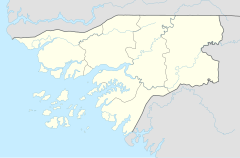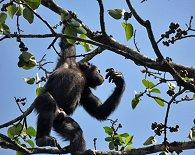Parque Nacional de Cantanhez
| Parque Nacional de Cantanhez | ||
|---|---|---|
|
|
||
| Location: | Tombali , Guinea-Bissau | |
| Specialty: | rare animal and plant species, jungle area | |
| Next city: | Bedanda and Vacine | |
| Surface: | 1067.67 km² | |
| Founding: | 2011 | |
| Address: |
www.ecocantanhez.org Tel. 00.245.552.3358 |
|
The Parque Nacional de Cantanhez (PNC, also Matas de Cantanhez ) is a national park in the south of the West African country Guinea-Bissau .
Like all eight nature reserves in the country, the Cantanhez National Park is subject to the public law Instituto da Biodiversidade e das Áreas Protegidas (IBAP).
The Cantanhez National Park, also known as Matas de Cantanhez ( Portuguese for “Cantanhez Forests”), is considered to be the country's last intact primeval forest . It is over 1067 km² and lies in a very rainy area, with an average rainfall between 2500 and 3000 mm per year.
location
The Cantanhez National Park is located in the Tombali region in the southwest of the country, its eastern border forms the border with neighboring Guinea-Conakry for a few kilometers . The national park is 258 kilometers south of the capital Bissau by road, the last 60 kilometers of which consist of a bad dirt road.
It extends over 1,067.67 km² (106,767 hectares ) and is located in the area of the three administrative sectors Bedanda , Cacine and Quebo .
history
The area was first placed under protection as the protected forest Matas de Cantanhez by the government of Guinea-Bissau in 1980.
In 1997 the country created the legal requirements for the establishment of national parks.
In 2004, the government transferred the management of the nature reserves in Guinea-Bissau to the newly created Instituto da Biodiversidade e das Áreas Protegidas (IBAP).
Since 2007, the nature reserve Cantanhez is as natural park Parque Natural de Cantanhez out in the records of the IBAP. In 2011 the national park was raised .
With the amendment of the Law on Protected Areas ( Lei das Áreas Protegidas e as Regras de Gestão , published in the Boletim Oficial Law Gazette No. 9 under the file number Decreto-lei Nº 5-A / 2011), the national park status of Cantanhez Park was legally established in 2011.
Local community
Residents
Around 20,000 people live in the area of the national park, spread over 13 larger villages ( Tabancas ). They belong to the six ethnic groups Balanta , Nalu , Tanda , Fulbe ( Fula ), Djacanca and Susso , which are often associated with related ethnic groups in neighboring Guinea, such as the cattle-breeding Fulbe from Fouta Djallon , the forest farmers of the Susso, or the Balanta, the cultivate naturally irrigated rice, which is common in the region.
Football club
The local football club Estrela de Cantanhez Futebol Clube is a nationally known ambassador for the region, its players are often referred to as homens das matas (Portuguese for "men of the woods") or "Equipa do Cantanhez" (for example "Cantanhez National Park team") ) occupied.
The club rose to the first division of Guinea-Bissau in 2015 , but had to relegate to the second division as bottom of the table after the 2017 season.
The club achieved its greatest success in 2013 when it surprisingly won the national cup as a third division team. He then played in the CAF Confederation Cup 2014, but was eliminated after the first round against the Red Lions from Liberia .
Estrela de Cantanhez FC welcomes its guests to the 1200-seat Estádio da Estrela in Cubucaré .
flora
The national park is mainly characterized by rainforests and mangrove forests . Here you will find the Anisophyllea laurina known as Pau mizeria (from the Anisophylleaceae family ), Mampataz ( Parinari excelsa from the golden plum family ), Pau veludo ( Dialium guineense from the legume family ), the Tagara tree ( Alstonia congensis from the Dog poison family ), the Faroba de lala ( Albizia gummifera from the Albizia family ) and a number of palm trees , including the oil palm .
fauna
A wide variety of mammals, birds, reptiles, fish and insects can be found here. Over 30 different mammals and around 40 species of fish are at home here. The seven animal corridors identified here are also important , two of them cross-border and two with a connection to the Parque Natural das Lagoas de Cufada and the future Dulombi National Park in today's Complexo Dulombi, Boé e Tchetche . Some endangered animal species find their way back to Cantanhez National Park through these corridors, including elephants .
The most famous mammals in Cantanhez National Park are the western chimpanzees ( Pan troglodytes ). In 2011, 287 nests were counted here, most of which they create (92%) in the branches of the oil palm .
Also are Cape buffalo , roan antelope , Whiskered colobus monkeys , warthogs , various Ducker - antelopes and various primates such as Guinea baboons and colobus species to name. A wide variety of birds can also be observed, including a wide variety of migratory birds . The pelicans are among the largest birds in the national park .
See also
Web links
- Website of the Cantanhez National Park (under construction, with a link to the Facebook page)
- Website of the Parque Nacional de Cantanhez at IBAP (port.)
- Profile of the Parque Nacional de Cantanhez (English) at www.kalmasoul.com
- The Cantanhez Forests at www.protectedplanet.net
Individual evidence
- ↑ a b c d e f Profile of the Parque Nacional de Cantanhez ( Memento of the original from January 6, 2018 in the Internet Archive ) Info: The archive link was automatically inserted and not yet checked. Please check the original and archive link according to the instructions and then remove this notice. at IBAP (port.), accessed on April 7, 2018
- ↑ Joana Petrolho, Marta Rosa: À Descoberta da Guiné-Bissau. , Afectos com Letras / EU, Pombal 2015, ISBN 978-989-20-6252-5 , p. 7.
- ↑ a b Joana Petrolho, Marta Rosa: À Descoberta da Guiné-Bissau. , Afectos com Letras / EU, Pombal 2015, ISBN 978-989-20-6252-5 , p. 94ff.
- ↑ Parcs de Guinee Bissau , Report of the International Union for Conservation of Nature IUCN 2007 (French, Portuguese), accessed on January 7, 2018
- ↑ Overview of the legal bases of the nature parks in Guinea-Bissau ( Memento of the original from January 6, 2018 in the Internet Archive ) Info: The archive link has been inserted automatically and has not yet been checked. Please check the original and archive link according to the instructions and then remove this notice. (port.), IBAP website, accessed January 7, 2018
- ↑ Overview of the football season 2015/16 in Guinea-Bissau from the Rec.Sport.Soccer Statistics Foundation , accessed on January 7, 2018
- ↑ a b Overview of the football season 2016/17 in Guinea-Bissau from the Rec.Sport.Soccer Statistics Foundation, accessed on January 7, 2018
- ↑ Overview of the 2013 football season in Guinea-Bissau from the Rec.Sport.Soccer Statistics Foundation, accessed on January 7, 2018
- ↑ Entry by Estrela de Cantanhez at www.africanfootball.com, accessed on January 7, 2018
- ↑ Entry by Estrela de Cantanhez FC on www.fussballzz.de, accessed on January 7, 2018
- ↑ Chimpanzee Oil-Palm Use in Southern Cantanhez National Park, Guinea-Bissau , retrieval of the study at www.researchgate.net, retrieved on April 7, 2018
- ↑ Profile of the Parque Nacional de Cantanhez (English) at www.kalmasoul.com, accessed on April 7, 2018

